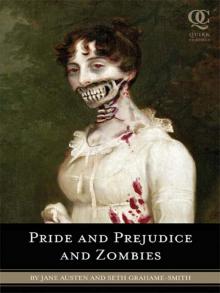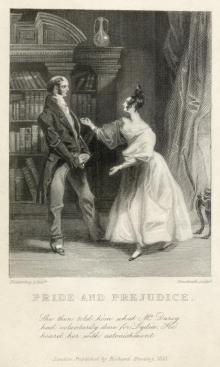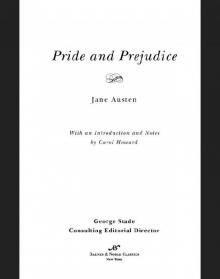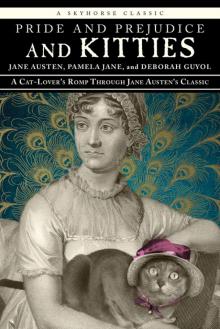- Home
- Jane Austen
The Annotated Mansfield Park Page 2
The Annotated Mansfield Park Read online
Page 2
EDITIONS AND ARTICLES CONSULTED
Chapman, R. W., ed. The Novels of Jane Austen, vol. III, Mansfield Park. Oxford: Oxford University Press, 1933.
Johnson, Claudia, ed. Mansfield Park: A Norton Critical Edition. New York: W. W. Norton, 1998.
Sabor, Peter. “Textual Controversies: Editing Mansfield Park.” Persuasions: The Jane Austen Journal 36 (2014): 34–43.
Southam, Brian. “Mansfield Park—What Did Jane Austen Really Write? The Texts of 1814 and 1816,” in British Women’s Writing in the Long Eighteenth Century: Authorship, Politics and History, edited by Jennie Batchelor and Cora Kaplan. New York: Palgrave Macmillan, 2005.
Sutherland, Kathryn, ed. Mansfield Park. London: Penguin Books, 1996.
Wiltshire, John, ed. The Cambridge Edition of the Works of Jane Austen: Mansfield Park. Cambridge: Cambridge University Press, 2005.
Acknowledgments
As in all the preceding volumes of this series, my foremost debt goes to my editor, Diana Secker Tesdell. She patiently coped with some delays in the composition of the book and then provided a continual series of valuable criticisms and revisions along with numerous valuable insights and suggestions. She made it a much better book than it would have been otherwise.
I also wish to express my gratitude to Kathleen Cook for excellent work in the very difficult and important task of laying out such a complicated book, as well as the efforts of others at Anchor Books who worked on this project at its various stages.
Additional thanks are owed to the staff of the Bethlehem Public Library, the New York State Library, the New York Public Library, and the Thomas J. Watson Library at the Metropolitan Museum of Art for helping me procure the materials essential for my research.
Finally, I must extend my appreciation to the fellow members of the local Jane Austen Society of North America for their support and encouragement in my continual immersion in the rich world of Jane Austen, and to the members of my family who have provided various types of essential support over the course of my long project of annotating her novels.
Introduction
Mansfield Park, the fourth of Jane Austen’s six complete novels, draws extensively—perhaps more than any of her other novels—on knowledge she acquired from her family members and on her personal experience of a variety of social levels.
Jane Austen was born on December 16, 1775, in the rural county of Hampshire in southern England. Her father, George Austen, was a clergyman, like the hero of Mansfield Park, and her mother, Cassandra Austen Leigh, while the daughter of a clergyman, also came from a family of landed gentry like the Bertrams. Jane Austen spent her entire youth in the same rural setting, and while her family lived modestly, they socialized with more prosperous members of the local gentry. Her parents had six boys and two girls, and they encouraged learning and a love of books among their children. Several of her brothers tried their hands at literary composition, and Jane, with family approval and support, began her own literary efforts at thirteen. These ranged from short, highly comical sketches, often parodying literature of the day, to more serious pieces that reveal the interest in delineation of character that marks all her novels. The family’s interest in literature extended to plays: Jane Austen made a few brief efforts in that genre, and she and other family members participated in a number of amateur theatrical performances like the one that figures prominently in Mansfield Park.
As she matured, Austen began to write entire novels. The first known example was Elinor and Marianne, probably written in 1795, when she was nineteen. In the following year she began First Impressions, which upon completion impressed her family sufficiently that her father sent the manuscript to a publisher; it was, however, rejected. Her third novel, probably completed in 1799, was Susan, the original form of Northanger Abbey. Surviving letters of hers from this period show her regularly attending balls and other social events and expressing an interest in men, though no evidence exists in this period of a sustained romance or an offer of marriage. She experienced a major change in 1801 when her father retired and moved the family to the popular spa and resort town of Bath. She lived there for five years and set substantial portions of two novels there. During this period her literary production slowed; her only new effort was an unfinished novel called The Watsons. At some point she also returned to Susan, and in 1803 a revised version was submitted to a publisher, who purchased the rights but never published it. Around the same time, she rejected, after briefly accepting, her one known offer of marriage. In 1805 her father died, and in 1806 reduced financial circumstances forced Jane, her mother, and her sister to leave Bath.
Austen continued to have frequent contact, including both letters and regular visits, with her brothers, and through them she expanded her knowledge of various matters central to Mansfield Park. Her eldest brother, James, succeeded their father in his clerical position; at one point while writing the novel she directed an inquiry to him regarding church practices. Another brother, Edward, had the good fortune to inherit a large estate and a grand home very like Mansfield Park. During several extended visits Austen commented on her often novel experiences there; she also had occasional exposure to relatives of her mother living in similar homes, including one that served as a model for the other grand estate in the novel, Sotherton Court. Her brother Henry, with whom she was especially close, moved to London and thereby gave her regular opportunities to enjoy its pleasures and become acquainted with life there. Finally, her two youngest brothers, Francis and Charles, became naval officers and were able to furnish her with invaluable information about the navy for this novel. Moreover, when she, her mother, and her sister left Bath, they moved in with Francis and his wife in the town of Southampton. Their three years there acquainted Jane Austen with the nearby town of Portsmouth as well as the much less comfortable conditions of life depicted in the Portsmouth sections of Mansfield Park, for in Southampton she lived in a crowded urban home and under greater financial constraint than at any other time in her life.
Eventually, in 1809, the three women were able to move into a comfortable cottage, owned by Jane’s brother Edward, in the Hampshire village of Chawton. Its quiet setting allowed Jane to dedicate herself more fully to writing. She began by revising Elinor and Marianne and successfully getting it published, in October 1811, as Sense and Sensibility; its title page said simply “By a Lady,” and she maintained this anonymity in subsequent books. This book’s modest success led her to revise First Impressions: the resulting Pride and Prejudice, appearing in January 1813, enjoyed even greater success. She next turned to entirely new compositions. Mansfield Park, which she began in 1812, was completed in 1813 and published in May 1814. While not enjoying the success of Pride and Prejudice, it did well enough to justify a second edition in 1816. Meanwhile, Emma appeared in December 1815, and a sixth novel, Persuasion, was already under way in that year. Unfortunately, even as knowledge and appreciation of her work was steadily growing, she began to suffer increasing illness during 1816, which probably forced her to make Persuasion a much shorter work than originally intended. Her health worsened in early 1817, and while still able to start another novel, Sanditon, she soon had to cease work. On July 18, 1817, she died. At the beginning of 1818 Persuasion and Northanger Abbey (the new title of her earlier novel Susan) came out together, along with a brief biographical notice by her brother Henry that finally revealed her identity to the world.
Mansfield Park occupies a curious position among Austen’s novels. It is the first of her mature novels, those composed completely when she was older and already an accomplished writer. These share several features that distinguish them from her earlier novels. Their stories rely less on dramatic, or melodramatic, events and on improbable coincidences. Their characters are more muted and subtle and less like the exaggerated “types” that populated the plays and novels of the period. They also explore more fully and intricately the inner psychology of the characters, especially the heroines. Finally, they focus more on depicting an
d evoking the atmosphere and social milieu within which the characters operate. All this means that even if they tend to lack the general high spirits of the early novels, and the sparkling cleverness and wit of the last and best of those, Pride and Prejudice, they offer greater depths and are accordingly seen by most commentators—and I certainly concur—as the summit of her art. This is especially true of the two longest of the three, Mansfield Park and Emma. Their greater length compared with all the others is itself a testimony to the author’s effort to extend herself artistically, and to her increased confidence.
In evaluating these two novels, recent opinion has most often rated Emma highest. But this was not always so. Commentators in the nineteenth and early twentieth centuries frequently preferred Mansfield Park. In 1862 the novelist and literary biographer Julia Kavanagh wrote that it is, “in the opinion of many, [her] most perfect novel,” while the journalist and essayist H. L. Mencken stated that in 1945, deciding to try Austen, “My choice, naturally, was ‘Mansfield Park,’ for all the authorities seemed to agree that it was the best.” *1 Also in 1945, the noted literary critic Edmund Wilson declared in a New Yorker article “that Mansfield Park is artistically the most nearly perfect of her novels.” *2 A few years later Wilson recommended the novel when asked by Vladimir Nabokov for advice on English works to include in an upcoming course on European fiction. Nabokov replied, “I dislike Jane, and am prejudiced, in fact, against all women writers. They are in another class. Could never see anything in Pride and Prejudice.” Wilson, however, persisted, declaring that Austen “is, in my opinion, one of the half-dozen greatest English writers (the others being Shakespeare, Milton, Swift, Keats, and Dickens).” This persuaded Nabokov to try Mansfield Park, and he was sufficiently impressed to include it in his course; his lecture notes, published in Lectures on Literature, contain many valuable insights.*3
Yet more recently not only has Mansfield Park fallen somewhat in critical favor, but it has also become, along with Northanger Abbey, by far the least popular of Austen’s novels among readers, which was not true earlier.
One probable reason for this is the serious moral and religious message of the book. The novel was influenced by the then-popular genre of evangelical fiction, which principally began with the appearance in 1808 of Coelebs in Search of a Wife, by Hannah More, a leader of the powerful evangelical movement and a writer of religious tracts. Her novel, the story of a morally upright man seeking a like-minded wife, inspired a spate of similar stories. Jane Austen was familiar with these books and commented on them in letters in a tone of limited respect combined with criticism. Another leading example was Self-Control (1811), by Mary Brunton, and Austen speaks in one letter of having tried unsuccessfully to get hold of a copy (April 30, 1811). She eventually succeeded, for she later declares, “I am looking over Self Control again, & my opinion is confirmed of its being an excellently meant, elegantly-written Work, without anything of Nature or Probability in it. I declare I do not know whether Laura’s passage down the American River, is not the most natural, possible, every-day thing she ever does” (Oct. 11, 1813). She makes a similar critique of Rosanne (1814), by Laetitia-Matilda Hawkins: “Mrs Hawkins’ great excellence is on serious subjects. There are some very delightful conversations and reflections on religion: but on lighter topics I think she falls into many absurdities; and, as to love, her heroine has very comical feelings. There are a thousand improbabilities in the story” (early 1815—exact date uncertain).
In Mansfield Park Jane Austen attempts a work that includes some of these novels’ serious concerns and themes, but departs from them on the critical issues of probability and realism.*4 As always, Austen presents a variety of human types who are complex and contain mixtures of good and bad qualities. Most important, while her hero is a man who intends to be a clergyman and has a deep sense of his vocation, he also spends most of the novel infatuated with, and often blind to the faults of, a woman who rejects most of the principles that he expounds so eloquently. Meanwhile, the similarly religious and earnest Fanny, while never making that serious an error, still succumbs at various points to feelings of jealousy or resentment. In all this Edmund and Fanny are unlike the paragons of perfection who typically served as the heroes and heroines of evangelical novels.
Yet even with this complexity of character, the story’s strict morality and religious themes, often an attraction to nineteenth-century readers, have proven less congenial, and even sometimes repellent, to many readers of the twentieth and twenty-first centuries, largely because of the changed mores of our times. Fanny and Edmund have been censured as sententious and priggish. The harsh punishment of the fallen Maria has provoked condemnation. Finally, the nefarious part played in the story by the young people’s amateur theatrical production has been seen variously as incomprehensible, ridiculous, or close-minded and philistine.
Another commonly expressed reason for dislike of the novel is dislike of Fanny Price herself. In forums and discussions on the Internet, the vehement disagreements relating to her have been sometimes labeled the “Fanny Wars.” She has aroused far greater animosity than any other Austen heroine, with the possible exception of the title character of Emma. Yet Emma is a heroine the reader is supposed to dislike initially, at least in part, because her flaws and her gradual correction of them are the center of the story. Fanny, in contrast, is meant to be a figure of sympathy throughout, and an exemplar of wise judgment and moral correctness, so dislike of her and rejection of her wisdom and virtue are inevitably a rejection of much of the underlying moral stance of the story. This animosity stems in part from reactions against her stringent moral code; the pettiness, envy, and bitterness she does display at times; and her negative judgment of her home and parents while staying in Portsmouth, which strikes some as excessively sensitive and finicky, if not snobbish and callous.
Moreover, even many of those who do not dislike or disapprove of Fanny find it hard to feel much enthusiasm or affection toward her. She, unlike the principal heroine in every other Austen novel, is almost completely humorless (a quality she shares with Edmund). Because of her quietness and reserve she often says little of note and rarely engages in the repartee that is a frequent highlight of Austen’s work. Her passivity and timidity also mean that she simply does less; the one significant action she takes in the novel is to refuse an offer of marriage. These qualities, along with her physical frailty, low social position, and frequent hardships, while they can make her an object of sympathy or even pity, form a barrier to her being an object of admiration or emulation.
Yet Fanny’s particular combination of traits does offer some appealing compensations. She draws on one of the most powerful literary archetypes, the Cinderella story, thanks to her relative poverty, her mistreatment (including by two selfish stepsister-like cousins), her almost-angelic gentleness and kindness, and her eventual vindication and reward. The wish to see justice done for her drives much of the suspense and interest of the plot for many readers.
Another advantage is simply the exploration of a character type that does not often figure at the center of novels. In all her previous novels, Jane Austen offered heroines who were outgoing and energetic, and generally confident as well; her last heroine before Fanny, Elizabeth Bennet of Pride and Prejudice, was distinctive particularly for her confidence and outspokenness as well as her wit. Austen shows throughout her works a fascination with the varieties of human character, and creates a vast array of distinctive characters, so it is not surprising to see her attempt a heroine as different as Fanny. Moreover, in doing so she can demonstrate how such a person, the very sort who is often ignored or neglected, if not scorned, can in fact possess many interesting or valuable qualities, an underlying strength that more than once inspires her to resist external pressures that most would not, and an extremely rich inner life.
In fact, Fanny arguably has the richest inner life of any character in Jane Austen: she is in many respects both the most intellectual and the most emotional of all
the heroines. She is very bookish, in part because her shyness and her lowly social position have caused her to turn to books for diversion and education and consolation. Her reliance on books, though it can lead to naivete, encourages her to relate the particulars of her experience to general principles, and this stimulates her many sustained reflections and allows important themes to emerge in her thoughts and words. At the same time, she reacts with extreme sensitivity to almost everything that occurs, which frequently causes her anguish and distress and leads at times to foolish overreactions or unattractive feelings. Her acute reactions and emotions, coupled with her strenuous efforts to guide and control her feelings through moral principles, create conflicts that can make even the most ordinary occurrence an occasion for inner drama.
These features of Fanny also result in a distinctive amount of action and drama that is not directly related to the heroine. Austen’s novels always contain the dual elements of a story involving a wide array of people and a single person through whose consciousness the story unfolds. This single consciousness focuses the novel, but it also means almost everything must transpire within her observation. This limitation proves less restrictive than usual in Mansfield Park, in great part due to Fanny’s special characteristics. Because she is so quiet and inconspicuous she is able to witness many important events, and because she is so sensitive and thoughtful she is able to understand more than others do; hence she can be peripheral to the action for much of the novel while still being present to the reader. Moreover, the continuing lively saga of her interior life means that she never ceases to be an object of interest. Finally, as a thoughtful and sympathetic listener, whose own sentiments are frequently not perceived by others, she becomes a sounding board, most notably for Edmund and Mary Crawford. They make her their confidante about their feelings for each other, while never suspecting Fanny’s love for Edmund, allowing their romance to play out substantially before her. All this permits Mansfield Park to go further than any other Austen novel in three important ways: the depiction of a variety of social milieus, the development of a number of complex characters, and the unfolding of a plot that is both eventful and realistic.

 Sense and Sensibility
Sense and Sensibility Persuasion
Persuasion Mansfield Park
Mansfield Park Northanger Abbey
Northanger Abbey Pride and Prejudice and Zombies
Pride and Prejudice and Zombies Pride and Prejudice
Pride and Prejudice Emma
Emma Persuasion (Dover Thrift Editions)
Persuasion (Dover Thrift Editions) Lady Susan
Lady Susan Northanger Abbey (Barnes & Noble Classics)
Northanger Abbey (Barnes & Noble Classics) Lady Susan, the Watsons, Sanditon
Lady Susan, the Watsons, Sanditon Darcy Swipes Left
Darcy Swipes Left Persuasion: Jane Austen (The Complete Works)
Persuasion: Jane Austen (The Complete Works) Mansfield Park (Barnes & Noble Classics Series)
Mansfield Park (Barnes & Noble Classics Series) Sense and Sensibility (Barnes & Noble Classics Series)
Sense and Sensibility (Barnes & Noble Classics Series) The Annotated Sense and Sensibility
The Annotated Sense and Sensibility Pride and Prejudice (Clandestine Classics)
Pride and Prejudice (Clandestine Classics) Persuasion (AmazonClassics Edition)
Persuasion (AmazonClassics Edition) Persuasion (Barnes & Noble Classics Series)
Persuasion (Barnes & Noble Classics Series) Complete Works of Jane Austen
Complete Works of Jane Austen The Watsons and Emma Watson
The Watsons and Emma Watson Northanger Abbey and Angels and Dragons
Northanger Abbey and Angels and Dragons Love and Friendship and Other Early Works
Love and Friendship and Other Early Works Emma (Barnes & Noble Classics Series)
Emma (Barnes & Noble Classics Series) Sanditon
Sanditon Pride and Prejudice (Barnes & Noble Classics Series)
Pride and Prejudice (Barnes & Noble Classics Series) Pride and Prejudice and Kitties
Pride and Prejudice and Kitties The Annotated Northanger Abbey
The Annotated Northanger Abbey Oxford World’s Classics
Oxford World’s Classics Northanger Abbey (Barnes & Noble Classics Series)
Northanger Abbey (Barnes & Noble Classics Series) The Annotated Persuasion
The Annotated Persuasion Emma (AmazonClassics Edition)
Emma (AmazonClassics Edition) The Annotated Emma
The Annotated Emma The Annotated Mansfield Park
The Annotated Mansfield Park The Annotated Pride and Prejudice
The Annotated Pride and Prejudice